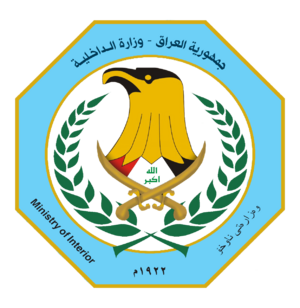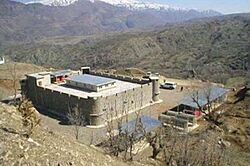Ministry of Interior (Iraq) facts for kids
The Ministry of Interior (MOI) is the government body charged with overseeing policing and border control in Iraq. The MOI comprises several agencies, including the Iraqi Police, Highway Patrol, Traffic Department, Emergency Response Unit, Explosive Ordnance Disposal Unit, and Department of Border Enforcement. Following passage of the Facilities Protection Service Reform Law, the Ministry absorbed FPS personnel previously spread among other ministries. The MOI has approximately 380,430 employees, and the Ministry of Finance approved US$3.8 billion for its 2008 budget, representing a 21% growth over the previous year.
Under President Saddam Hussein, the ministry performed a wide range of functions, including keeping Iraq free of Hussein's enemies and others deemed "undesirable." When U.S.-led Coalition forces found and captured Hussein during the Iraq War, the ministry was not dissolved, unlike the defense ministry and intelligence agencies. Combined Joint Task Force 7 planned to hand over policing and internal security duties as soon as possible. Instead, the ministry was merely restructured.
Contents
Organization
Federal Police (FP)
The Federal Police (FP), sometimes called the National Police, is a gendarmerie-type paramilitary force designed to bridge the gap between the local police and the army. This allows the MOI to project power across provinces and maintain law and order, while an effective community police is developed. Although called police, the force has been trained primarily for military operations.
Amid frequent allegations of abuse and other illegal activities, in the fall of 2006 the Iraqi government decided to reform and retrain all FP units. The FP transformation yielded a police organization capable of performing criminal investigations as well as tactical operations, and included a reorganization that resulted in the replacement of two division headquarters with a federal police headquarters.
FP units are equipped with small arms, machine guns, pick-up trucks, and SUVs. The mechanized battalions are equipped with light armored vehicles.
Department of Border Enforcement (DBE)
The DBE is tasked with securing and protecting Iraq's international borders from unlawful entry of both personnel and materiel. The DBE mans 405 border structures. As of March 2010, the DBE has approximately 40,000 personnel assigned, organized into 5 regions, 12 brigades and 38 battalions. The DBE was headquartered in Baghdad.
In late January 2009, the 1st Region, DBE, controlled the northeastern parts of Iraq which is the territory of the Federal Kurdistan Region and its where the country shares borders with Turkey and Iran. The 1st Region, considered one of the safest areas of Iraq currently, contains cities like Irbil, Dahuk and Sulyamaniah. Mosul was in the 2nd Region, Diyala was in the 3rd Region, Bashrah is in the 4th Region and the cities of Nyjaf and Nakheb are in the 5th Region."
Law Maj. Gen. Fazladin Abdulqader Mohammed of Bamarni, Iraq, was the commander, 1st Region, DBE. The 1st DBE Region "[had] the longest border of all the regions in Iraq," said Fazladin. "Our border covers from Fairozkan to Al Khabour, where the Tigris River Border Fort is located. It is 1,083 kilometers and we have three brigades for this region, the 1st Brigade, DBE, in Dahuk, 2nd Brigade, DBE, in Diyana and 3rd Brigade, DBE, in Sulyamaniah." All three of these brigades were made up of Kurdish Peshmerga.
In October 2009 the 9th Brigade DBE was responsible for the Iranian border, and the 11th Brigade, responsible for the Saudi border, in Muthanna Governorate.
The 15th DBE Brigade in Anbar Province was confirmed operational in January 2010.
Both the DBE and the Department of Ports of Entry (POE) were supposed to be equipped with AK-47s, medium machine guns, body armors, medium pick-up trucks, mid-size Sport utility vehicles, generators and radios.
Seven DBE brigades in southern Iraq survived the ISIS onslaught of the northern summer of 2014, but five brigades based largely on the Syrian border were disbanded. (Knights, Long Haul, 9)
In February 2024, the Ministry of Interior announced that a border guard brigade had been dispatched to secure the Iraqi-Turkish border in Duhok Governorate
Facilities Protection Service
The Facilities Protection Service has more than 150,000 personnel who work for 26 ministries and eight independent directorates. Anecdotal evidence suggests that some of them are unreliable and responsible for violent crimes. Former Prime Minister Maliki announced a reform to consolidate all Facilities Protection Service personnel into a unified organization responsible to the MOI. As of December 2005[update], the Coalition no longer provided material or logistical support to the FPS.
National Security Service
The Iraqi National Security Service (NSS) is the Service that undertakes the use of intelligence and security means in clear scientific, technical and methodological ways to preserve the state from threats that aim to undermine the state’s entity, the security and stability of society, and the development of its other basic interests, in cooperation with other concerned state agencies.
Federal Intelligence and Investigations Agency
The Federal Intelligence and Investigations Agency (FIIA) was founded in 2003, specializing in collecting intelligence information pertinent to national security through confidential and public sources, as well as auditing, analysing, and producing intelligence reports regarding the fight against terrorism and organized crime. The FIIA seeks to contribute to internal security by identifying risks and their levels, and providing advice to decision makers at all times. It has 3 working directorates: Directorate of Intelligence and Counter-Terrorism, Directorate for Combating Organized Crime, and Directorate of Technologies and Information Technology.
Special Police Commandos
The Special Police Commandos were an elite counter-insurgency unit answering to the Ministry of the Interior. In June 2004, the CPA transferred sovereignty to the Iraqi Interim Government. Under the new Prime Minister, Ayad Allawi, the CPA appointed a new interior minister, Falah al-Naqib.
After the poor performance of the police in battles against Shiite cleric Muqtada al-Sadr's Mahdi Army, Al-Naqib sought to provide the MOI with effective Iraqi constabulary forces. Al-Naqib created “commando units” of former soldiers from elite units such as Saddam's Republican Guard. These units, commanded by al-Naqib's uncle, Adnan Thabit, a former army general, were personally loyal to the minister. The commandos were trained initially without U.S. involvement. They were under MOI control, and were outside the scope of the U.S. Civilian Police Assistance Training Team (CPATT) assistance program. The U.S. military provided arms and logistical support to these units, who proved to be effective under Minister al-Naqib's stewardship in fighting alongside U.S. forces against Sunni insurgents and Shiite militias.
The existence of the unit was officially announced in September 2004 and numbered about 5,000 officers. Its principal U.S. adviser (Counselor) was Colonel James Steele, who also commanded the U.S. Military Advisory Group in El Salvador from 1984 through 1986.
The Special Police Commando Division, Public Order Division, and Mechanized Police Brigade were merged in 2006 to form the National Police. The National Police has since expanded and been renamed the Federal Police.
List of Interior Ministers
| Name | Portrait | Term of office | Political party | Prime Minister | |||
|---|---|---|---|---|---|---|---|
| Nuri Badran | September 2003 | April 2004 | Iraqi National Accord | Rotating | |||
| Samir Sumaidaie |  |
April 2004 | June 2004 | Independent | |||
| Falah Hassan al-Naqib |  |
June 2004 | April 2005 | Iraqi National Accord | Ayad Allawi | ||
| Baqir Jabr al-Zubeidi |  |
April 2005 | 20 May 2006 | UIA/ISCI | Ibrahim al-Jaafari | ||
| Nouri al-Maliki |  |
20 May 2006 | 8 June 2006 | State of Law Coalition (Islamic Dawa Party) |
Nouri al-Maliki | ||
| Jawad al-Bulani |  |
8 June 2006 | 21 December 2010 | Iraqi Constitutional Party | |||
| Nouri al-Maliki |  |
21 December 2010 | 8 September 2014 | State of Law Coalition (Islamic Dawa Party) |
|||
| Mohammed Al-Ghabban |  |
18 October 2014 | 8 July 2016 | State of Law Coalition (Badr Organization) |
Haider al-Abadi | ||
| Qasim al-Araji | 30 January 2017 | 25 October 2018 | State of Law Coalition (Badr Organization) |
||||
| Adil Abdul-Mahdi (interim) |  |
25 October 2018 | 24 June 2019 | Supreme Islamic Iraqi Council | Adil Abdul-Mahdi | ||
| Yassin al-Yasiri | 24 June 2019 | 6 May 2020 | National Wisdom Movement | Adil Abdul-Mahdi | |||
| Othman al-Ghanmi | 7 May 2020 | 28 October 2022 | Mustafa Al-Kadhimi | ||||
| Abdul Amir al-Shammari | 28 October 2022 | incumbent | Mohamed S. Al-Sudani | ||||
See also
- Popular Mobilization Forces





